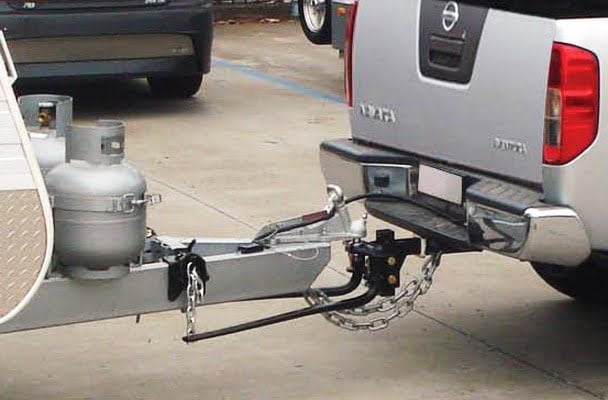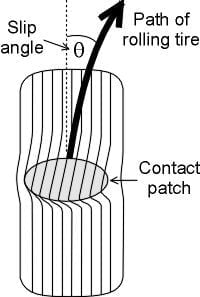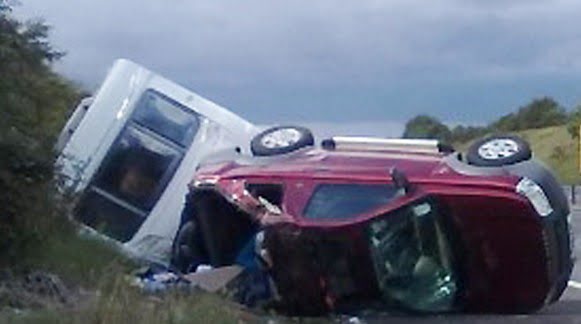by Collyn Rivers
Need for a WDH
Long end-heavy travel trailers have a need for a Weight Distributing Hitch (WDH). For all trailers, though, it inherently reduces tow vehicle stability. Here’s how and why.

Typical WDH (weight distributing hitch) Pic: Jayco.
Need for a WDH – Tow Ball Mass
Within limits, travel trailers must be nose heavy. For light European-style travel trailers with (desirable) centralised mass and loading, the improvement becomes less when nose mass rises above 6-7 per cent of the total weight. These travel trailers neither have a WDH nor provision for one.
Locally made travel trailers, however, have become longer and heavier (some exceed 4.0 tonne). They need a high nose mass of at least 10% at all times. Such nose weight (up to 350 kg [770 lb]) however is imposed on a hitch that overhangs the tow vehicle’s rear axle. The effect is like pushing down on the handles of a wheelbarrow. It levers up the front wheels of the tow vehicle. This (in effect) lessens the grip of the (steering) front tyres.
To counteract this, a WDH (a springy semi-flexible beam) attached between travel trailer and tow vehicle, levers the front wheels back down. This wholly or partly restores the weight. But whilst partially fixing that frontal weight problem it inherently introduces another.
The WDH issue
Only too often overlooked, whilst a WDH assists the front end weight issue, it cannot compensate for yaw (snaking) forces.

The beginning of a jack-knife. Side forces on a tow ball cannot be corrected by a WDH. Pic: copyright rvbooks.com.au
Worse – by reducing the imposed nose weight on the tow vehicle’s rear tyres – it reduces their ability to counteract those yaw forces. That, in turn, causes them to run wide – in effect introducing the unstable result shown above.
Need for a WDH – how tyres behave
The area of a tyre in contact with the road (called its ‘footprint’) is about the size of a human hand. When the steering wheel is turned, the front wheel-rims exert a side force on the tyre walls. That, in turn, distorts their footprints, causing the vehicle to take up the desired direction. For the same reason, any side force will cause a tyre to have a steering effect. This includes rear tyres when subjected to yaw forces.

Here’s how a tyre behaves when steered – or subjected to a side force.
A correctly cornering rig follows the dotted line shown below – i.e. it runs very slightly wide. That running-wide effect is known as understeer. It automatically reduces the risk of jack-knifing. The red dotted line shows what happens if understeer is too great.

Pic: original source unknown.
When a heavy travel trailer yaws, the WDH’s reduction of rear tyre loading reduces their ability to resist the imposed yaw forces. This disturbs their required ratio of grip and slip angle action front/rear. If the rear slip angle exceeds a critical level the result is so-called oversteer. It may build-up to that shown below – dotted red line – where those (rear) tyres may lose all grip

If the rear tyres increasingly cause the vehicle to self-tighten the turn (oversteer), the result may result in final jack-knifing. Pic: original source unknown.

Travel trailer jack-knife in the UK – Pic: original source unknown.
Need for a WDH – adjusting a WDH
It has been known since the late 1970s that using a WDH to compensate for loss of tow vehicle front end weight prejudices the tow vehicle’s desired handling. If the WDH is adjusted to fully compensate it introduces a loss of cornering ability of 25-30%.
In physics terms, it reduces it from about 0.4 g down to about 0.3 g. (the ‘g’ refers to the force of gravity). A rough guide to this is that many local road authorities have ‘Recommended cornering Speed’ signs. cornering at that speed usually corresponds to about 0.2 g.
Despite this, until recently recommendations have been to adjust a WDH to fully counteract travel trailer nose ball weight. Now, however, following recommendations (in a major study – SAE J2807), the world’s major maker of WDHs (Cequent – Hayman Reese) advises adjusting to correct tow ball mass by 50% only. This typically results in the travel trailer‘s nose being lower by about 50 mm. This is desirable anyway as airflow under the front of a travel trailer tends to cause it to undesirably lift.
Need for a WDH – tyre pressures when towing
Regardless of using a WDH or not, when towing increase the tow vehicle’s rear tyre pressure by about 50-70 kPa (7-10 psi). This virtually restores the previous steering characteristics. Do not vary the tow vehicle’s front tyre pressure: that should be whatever the vehicle maker advises.
Need for a WDH – summary
The above issues have long been well understood. They have been substantially addressed in the EU, and also followed by EU travel trailer firms now building travel trailers in Australia. They are also covered in associated articles on this website. Be aware that a WDH should only be used where necessary. This typically where the laden travel trailer is heavier than the laden tow vehicle. Also for most travel trailers over 5.5 metres (approx. 18 feet).
Need for a WDH – further information
The general topic is covered (more technically and in-depth) in my article Travel trailer and Tow Vehicle Dynamics. See also Reducing travel trailer sway, also Making travel trailers stable
See also the excellent UK/EU related: caravanchronicles.com/guides/understanding-the-dynamics-of-towing/
If you found this article of value, my books will prove even more so. They include Caravan & Motorhome Electrics, Solar That Really Works (for RVs), Solar Success (for home and property systems), and The Camper Trailer Book. The author’s Caravan & Motorhome Book covers every aspect of the subject matter.
To assist others please consider posting a Link to this article on related forum queries
* Darling J., Tilley D., and Gao B., 2008. An experimental investigation of car-trailer high-speed stability. Dept of Mechanical Engineering, University of Bath, UK.




